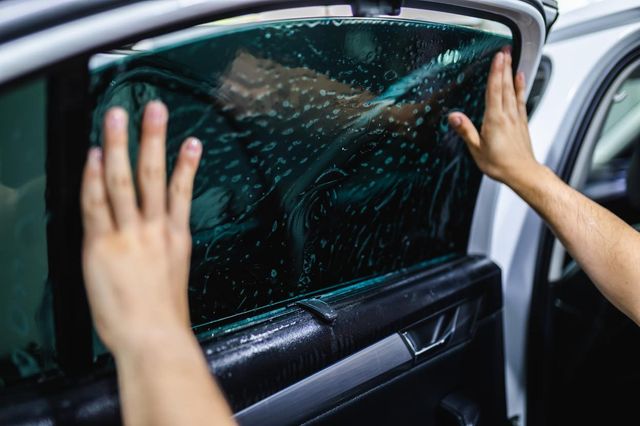Automobile Window Tinting for Boosted Safety and Lowered Burglaries
Automobile Window Tinting for Boosted Safety and Lowered Burglaries
Blog Article
Home Window Tinting Rules and Guidelines: What You Need to Know Prior To Tinting Your Vehicle
Before continuing with home window tinting for your vehicle, it is vital to acquaint yourself with the varied laws and guidelines that regulate this method throughout different states. These laws dictate the permissible degrees of tint darkness, usually measured by visible light transmission (VLT) percentages, and consist of certain terms for front windshields aimed at ensuring roadway security.
Review of Window Tinting Regulations
Home window tinting legislations are frequently subject to variation across various territories, reflecting local guidelines and safety and security factors to consider. These legislations determine the acceptable degrees of tint darkness and reflectiveness on vehicle windows, guaranteeing that chauffeurs keep sufficient visibility while also safeguarding versus unsafe UV rays and heat.
Many policies identify home window tinting based on the Visible Light Transmission (VLT) percent, which suggests the amount of light that can pass with the home window. Typically, lower VLT portions symbolize darker colors. Laws often separate in between the front, side, and rear home windows, with more stringent constraints related to the front windshield to boost safety for both the vehicle driver and other road individuals.
Compliance with window tinting policies is important, as violations can result in penalties, necessary elimination of the tint, and possible increases in insurance coverage premiums. It is important for vehicle owners to familiarize themselves with local laws prior to proceeding with window tinting installments.
State-by-State Color Rules
Comprehending the certain window tinting policies in each state is important for vehicle proprietors seeking to conform with the regulation. Each state in the united state has established its own collection of rules governing home window tinting, which can vary substantially. These laws typically determine the allowable degrees of tint darkness, the sorts of home windows that can be tinted, and any medical exceptions that might use.
For example, states like California have strict restrictions on tint darkness for front windows, while others, such as New Mexico, may enable darker colors. Additionally, particular states mandate details visibility portions for numerous home windows, including the windscreen, front side windows, and back home windows. It is critical for vehicle owners to acquaint themselves with their state's regulations to stay clear of possible penalties or fines.
Moreover, some states might call for a qualification sticker to be put on colored windows, indicating conformity with state laws. Failure to stick to these guidelines not only runs the risk of legal effects yet can additionally affect safety and presence while driving. Vehicle owners should carry out complete research study or seek advice from regional authorities to guarantee complete understanding and compliance with state-by-state tint regulations.
Allowed Color Kinds and degrees
Several automobile owners may be shocked to find out that allowed color levels and types vary extensively throughout various states. Each state has established its very own laws concerning the permissible darkness and reflectivity of window tint, typically determined by Visible Light Transmission (VLT) percentages. VLT describes the amount of light that can pass via the tinted windows; thus, a reduced percentage shows a darker tint.

Moreover, the sorts of color materials enabled can vary, with some states prohibiting metallic or mirror-like surfaces. It is crucial for car owners to acquaint themselves with their state's particular legislations to make sure compliance. Non-compliance can lead to penalties, compulsory removal of the tint, or other lawful consequences, making it imperative to understand these guidelines before waging installation.
Medical Exceptions for Tinting
While not all states provide allocations for clinical exceptions concerning home window tinting, those that do recognize the necessity for particular people to boost visibility and comfort because of medical problems. Different medical conditions, such as lupus, skin cancer, and certain eye disorders, can make individuals specifically conscious sunshine. These individuals might require darker colors to shield themselves from unsafe UV rays and glow.

It is very important to keep in mind that despite a medical exception, there might still be limitations on the degree of tint enabled. Compliance with state regulations makes sure that individuals are both secured and within lawful restrictions. Those taking into consideration medical exemptions must contact their regional Division of Motor Vehicles or equivalent authority to comprehend check this site out the needs and procedures needed to make an application for an exception effectively.
Penalties for Non-Compliance
Stopping working to comply with home window tinting legislations can cause substantial charges, which vary by state. Legislation enforcement agencies are equipped to provide citations for lorries that do not adhere to the specified tinting policies. These fines normally consist of fines, which can range from moderate quantities to several hundred bucks, relying on the extent of the offense and the state concerned.
In some territories, duplicated offenses might result in rising penalties or extra charges, such as obligatory court appearances. Furthermore, non-compliance may necessitate the removal of prohibited tinting, typically at the owner's expenditure. In extreme instances, regular culprits may encounter suspension of their vehicle registration till conformity is accomplished.
Additionally, insurance policy effects might arise from receiving several citations for window color violations. Insurance providers might check why not find out more out such violations as a sign of riskier behavior, possibly bring about increased costs or problem in protection.
To prevent these penalties, it is important for automobile owners to acquaint themselves with their local home window tinting legislations and guarantee that their vehicle complies (Window Tinting). This positive approach not just prevents lawful ramifications but also advertises road security
Final Thought

A lot of laws classify home window tinting based on the Visible Light Transmission (VLT) percentage, which shows the amount of light that can pass via the home window. Conformity with home window tinting regulations is vital, as infractions can result in penalties, necessary removal of the tint, and potential increases in insurance policy costs.Comprehending the certain window tinting guidelines in each state is crucial for lorry owners seeking to comply with the regulation. These laws commonly determine the allowable degrees of tint darkness, the types of windows that can be tinted, and any type of clinical exceptions that might use.
For instance, states like The golden state have rigid constraints on color darkness for front home windows, while others, such as New Mexico, may allow darker colors.
Report this page